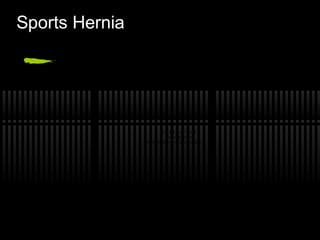
Sports hernia good
- 1. Sports Hernia QuickTime™ and a decompressor are needed to see this picture.
- 2. What is a Sports Hernia • A sports hernia is a very complex injury that is extremely hard to diagnose because of the many specific muscles, tendons, ligaments, and tissues it can involve. • Sports hernias are used as an umbrella term to characterize a groin injury caused by the imbalance of strength between the lower abdominal muscles, and the muscle of the medial thigh (mostly adductors). • Naturally athletes develop stronger adductor muscles, because the lower body is trained more than their core. • This imbalance in strength becomes a problem because various muscles and tissues of the abdomen and adductors share sites of attachment in areas such as the pubis.This creates a “tug of war” type stress on the bones, muscles, tendons, and ligaments of the groin area. QuickTime™ and a decompressor are needed to see this picture.
- 3. Specific Examples and Anatomy QuickTime™ and a decompressor are needed to see this picture. QuickTime™ and a decompressor are needed to see this picture. The inguinal ligament attaches at the anterior superior iliac spine and the pubic tubercle, and is a site of origin and insertion for multiple muscles and tissues of the abdomen, and medial thigh. The rectus abdominis site of insertion lies on the inguinal ligament, while muscles of the adductors attach at where at the pubic tubercle where it meets the inguinal ligament. For a sports hernia to occur, the a section of the abdomen(usually the transversalis fascia, external obliques or rectus abdominis) must suffer a strain tear, or thinning in the muscle tissue. Once a part of the abdomen has been weakened the pelvic area cannot cope with the imbalance of strength, causing injury to areas of the groin. In many cases the inguinal ligament suffers most from the “tug of war” that ensues when playing an explosive sport that requires twisting, kicking, or awkward contact. on the left we see an injured rectus abdominis where it inserts at the inguinal ligament, and on the right we see a weakened abdominal wall called the transversalis fascia( fascia of the abdominal wall that runs underneath the obliques and along the inguinal ligament)
- 4. Conservative Treatment Non surgical treatment of a sports hernia is most often used as a coping mechanism, allowing the athlete to perform until they are able to have surgery. Because sports hernias are hard to diagnose many athletes treat it as a strained groin with rest and physiotherapy. These techniques are also used in the case of sports hernias, however the physical therapy would focus on strengthening the core, and controlling lateral movements. In some cases rest, ice, physiotherapy, tape, and compression shorts will allow the athlete to play through the pain continue postponing surgery. Without surgery the groin pain will almost always become a chronic reoccurring issue. QuickTime™ and a decompressor are needed to see this picture. QuickTime™ and a decompressor are needed to see this picture.
- 5. Surgery Sports hernias are now surgically treated in two main categories, laparoscopic surgery (minimally invasive) and the traditional open surgery. Up until recently sports hernias were only operated on under the traditional open method, which involve reattaching the rectus abdominis, conjoined tendon, and/or transversalis fascia to the pubis and inguinal ligaments, along with polypropylene mesh that supports and reinforces the injured area. After an open surgery the athlete must take 6 weeks to simply recover and rehabilitate from the surgery. After these 6 weeks the athlete can expect to be back in play in a minimum 3 months; pending symptoms the athlete may experience, and the success of physiotherapy. Laparoscopic surgery is a fairly new technique used on sports hernias and has reduced the recovery time of athletes who qualify for the surgery significantly. This surgery involves a number of small incisions in the inguinal area so that a surgical camera(laparoscope or endoscope) can be inserted in order to pinpoint where exactly the damaged area is. Surgical instruments are then used through the other incisions to reinforce the injured area of the abdominal wall with polypropylene mesh and surgical tacks.
- 6. Additional procedures Adductor Tenotomy: a surgical procedure where the tendon that attaches the adductor to the pubis is cut, allowing it heal at a longer length, relieving tension. Illioinguinal Neurectomy: Process of cutting or releasing the inguinal nerve in order to relieve pain. QuickTime™ and a decompressor are needed to see this picture.
- 7. QuickTime™ and a decompressor are needed to see this picture.
- 8. Adrian Peterson “I just remember getting twisted up pretty bad in an awkward position. My jersey never moves like that. I don't know if it was from a tackle or from me pulling away from someone. I just remember thinking when I saw my jersey like that, that I must've gotten twisted up pretty bad” (Adrian Peterson) QuickTime™ and a decompressor are needed to see this picture.
Hinweis der Redaktion
- https://www.facebook.com/emily.hanaka#